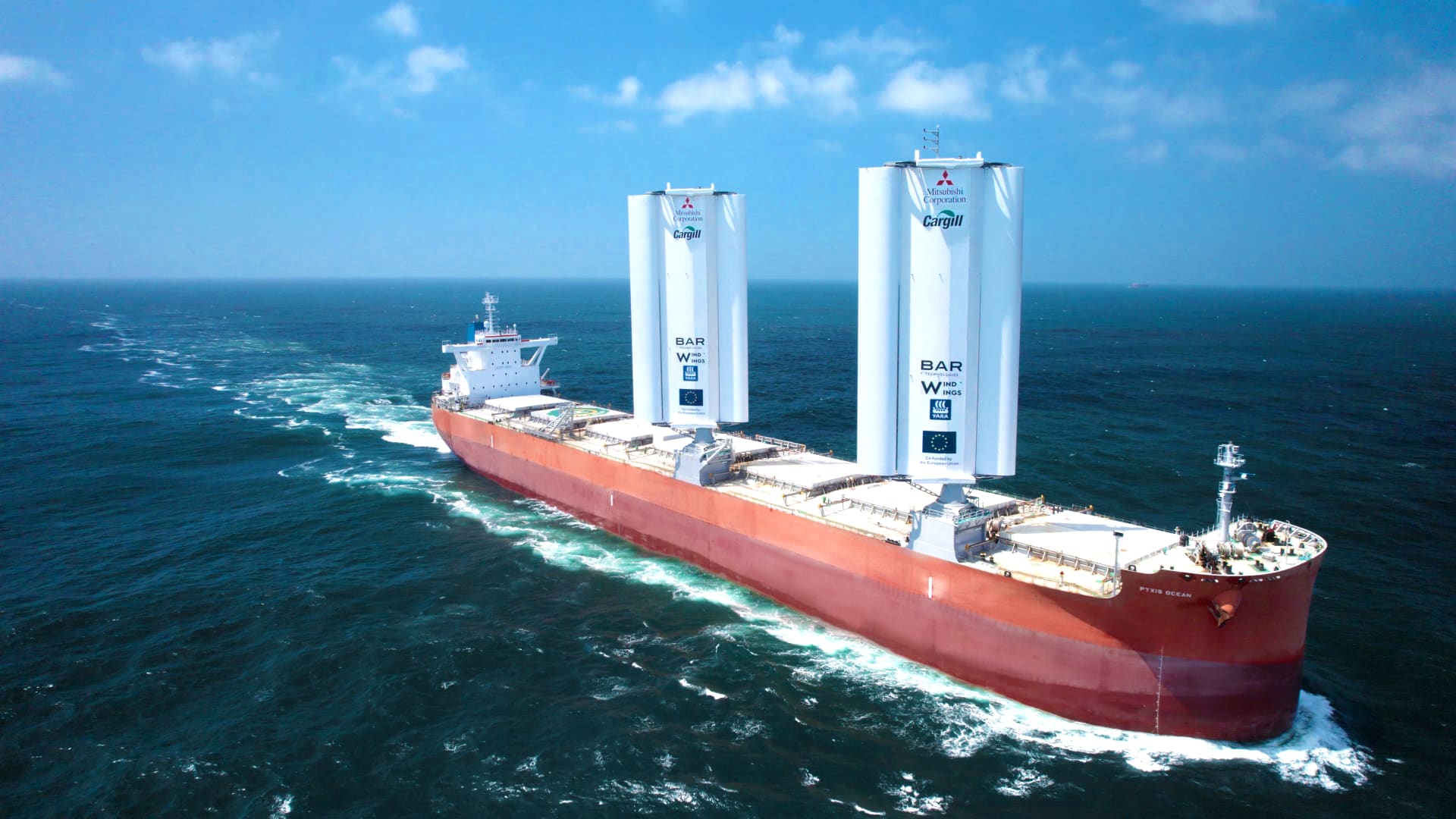A cargo ship with a difference is set to dock at the Polish port of Gdynia early next week.
The Pyxis Ocean, a bulk carrier that is 229 meters long and 32 meters wide, looks like any other dry cargo vessel — but with a big difference: it is fitted with two large, rigid sails known as WindWings.
These 37.5-meter-tall wings use wind power to help propel the vessel and in doing so reduce the amount of fuel it uses in an effort to cut carbon — shipping accounts for nearly 3% of the world’s greenhouse gas emissions.
The ship set sail from Shanghai, China, on Aug. 1, with around 20 crew onboard, and its voyage took it to Paranagua, Brazil in September before it set sail for the Spanish island of Tenerife, and then on to Poland. The wings have been folded down when the ship docked at ports on its journey.
The WindWings were added to the six-year-old vessel with the aim of cutting fuel use by about 20% on the voyage, according to Jan Dieleman, president of Cargill Ocean Transportation, which chartered the Pyxis Ocean.
Net zero goals
Cargill’s calculations suggest that WindWings could contribute to around a 30% reduction in fossil fuel consumption when three wings are installed on a new build ship — but if that vessel is powered with a biofuel, that figure could go up to 50%, Dieleman said.
In July, the maritime industry agreed to reduce emissions to net zero “by or around” 2050, but given the size and complexity of the sector, issues such as a lack of green fuels could cause delays.
“Wind is not going to get us to zero — unless we’re all willing to switch off the engines and go back in time … But what we’re trying to do here with this specific technology, is somehow combine the best of both worlds, still have reliability [with an engine], but reduce significantly the fuel usage,” Dieleman told CNBC by video call.
Biofuels such as green methanol and green ammonia are more costly than fossil fuels, and it’s not simply a case of switching one for another: methanol has about half the energy density of hydrocarbons so need larger tanks, for example.
“If you can reduce the volume [of fuel] by 30% you have another gain, [in] that you don’t have to put your ship all full of tanks instead of cargo capacity,” Dieleman said.
“I do get very excited with the combination of wind plus the new fuels, because new fuels [are] three, four times more expensive, then [by adding wind power] your payback is probably going to be two, three years instead of 10 years,” he added. This might encourage more ship owners to participate in schemes like this, because they are potentially more financially rewarding and less risky, Dieleman said.
Cargill has ordered five methanol-powered bulk carrier vessels, the first of which was ordered in 2022, before the WindWings were tested at sea. Once the wings’ performance has been evaluated, Cargill hopes to work with the shipyard building the new vessels to add WindWings to their design.
While the Pyxis Ocean’s voyage has been relatively smooth, there have been some ports that were reluctant to accept it, “because it’s different,” Dieleman said. “It takes us time to get innovation in a very traditional industry … even with the best will and the best people trying to push this, you still have a lot of hoops to go through,” he added.
The WindWings are not suitable for all vessels: it wouldn’t be possible to install them on a cargo ship that carries large containers that are many layers tall, for example. Bulk carriers like the Pyxis Ocean store their goods — such as grain — inside their cavities, below deck.
Shipping is a complex industry with many parties involved in funding and developing new technology, and it has taken four years since the beginning of the project for the Pyxis Ocean to set sail, Dieleman said.
The WindWings were developed by Cargill with naval architect Bar Technologies, and produced by Yara Marine Technologies, while the Pyxis Ocean is owned by Mitsubishi Corporation.
“This is this is a prime example, I think, of where people come together, and really genuinely [are] willing to make a difference, taking some risk. We have an owner that is letting us cut big holes in the ship — that that is not what every owner in the world is willing to do,” Dieleman said.
